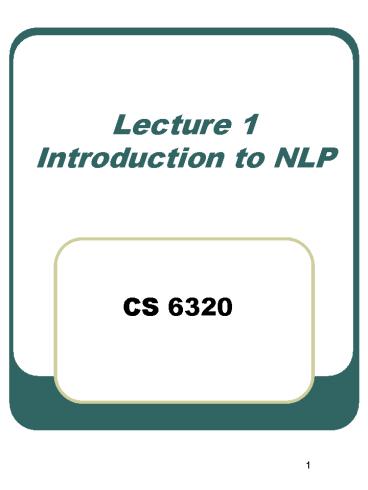Lecture 1 Introduction to NLP - PowerPoint PPT Presentation
1 / 13
Title:
Lecture 1 Introduction to NLP
Description:
Sometimes it is possible to use grammar rules (like subject verb agreement) to disambiguate: ... (at tennis , or murdered her) 11. Example of NLP difficulties 4 ... – PowerPoint PPT presentation
Number of Views:47
Avg rating:3.0/5.0
Title: Lecture 1 Introduction to NLP
1
Lecture 1Introduction to NLP
CS 6320
2
Definition
- NLP is a technology that creates and implements
computer models for the purpose of performing
various natural language tasks. It is used for
building NL interfaces to databases, machine
translation, and others. - NLP is playing an increasing role in curbing the
information explosion on Internet and corporate
America.
3
Related areas
- NLP is a difficult, and largely unsolved problem.
One reason for this is its multidisciplinary
nature - Linguistics How words, phrases, and sentences
are formed. - Psycholinguistics How people understand and
communicate using human language. - Computational linguistics Deals with models and
computational aspects of NL (e.g. algorithms).
4
Related areas
- Philosophy relates to the semantics of language
notion of meaning, how words identify objects.
NLP requires considerable knowledge about the
world. - Computer science model formulation and
implementation using modern methods. - Artificial intelligence issues related to
knowledge representation and reasoning. - Statistics many NLP problems are modeled using
probabilistic models. - Machine learning automatic learning of rules
and procedures based on lexical, syntactic and
semantic features. - NL Engineering implementation of large,
realistic systems. Modern software development
methods play an important role.
5
Applications of NLP
- Text - based applications
- Finding documents on certain topics (document
classification) - Information retrieval search for key words or
concepts, - Information extraction extract information
related to key words, - Complete understanding of texts requires a deep
structure analysis, - Translation from a language to another,
- Summarization,
- Knowledge acquisition.
- Dialogue - based applications (involve human -
machine communication) - Question - answering
- Tutoring systems
- Problem solving.
- Speech processing
6
Basic levels of language processing 1/2
- Phonetic - how words are related to the sounds
that realize them. Essential for speech
processing. - Morphological Knowledge - how words are
constructed e.g friend, friendly, unfriendly,
friendliness. - Syntactic Knowledge - how words can be put
together to form correct sentences, and the role
of each play in the sentence. e.g. - John ate the cake.
- Semantic Knowledge - Words and sentence meaning
- They saw a log.
- They saw a log yesterday.
- He saws a log.
7
Basic levels of language processing 2/2
- Pragmatic Knowledge- how sentences are used in
different situations(or contexts). - Mary grabbed her umbrella.
- a) It is a cloudy day.
- b) She was afraid of dogs.
- Discourse Knowledge - how the meaning of words
and sentences is effected by the proceeding
sentences pronoun resolution. - John gave his bike to Bill.
- He didn't care much for it anyway.
- World Knowledge - the vast amount of knowledge
necessary to understand texts. Used to identify
beliefs, goals. - Language generation - have the machine generate
coherent text or speech. Needs planning.
8
Examples of NLP difficulties 1/4
- A major difficulty is lexical ambiguity. There
are three types - Structural ambiguity- when a sentence has more
than one possible parse structures e.g.
attachment - John saw the boy in the park with a telescope.
9
Examples of NLP difficulties 2/4
10
Examples of NLP difficulties 3/4
- Syntactic ambiguity- when a word has more than
one part of speech - Rice flies like sand.
- Note that these syntactic ambiguities lead to
different parse structures. Sometimes it is
possible to use grammar rules (like subject verb
agreement) to disambiguate - Flying planes are dangerous.
- Flying planes is dangerous.
- Semantic ambiguity- when a word has more than
one possible meaning (or sense) - John killed the wolf.
- John killed the project.
- John killed that bottle of wine. John
killed Jane. (at tennis , or murdered her)
11
Example of NLP difficulties 4/4
- Ambiguities of a sentence
- Example
- I made her duck.
- Possible interpretations
- I cooked waterfowl for her.
- I cooked waterfowl belonging to her.
- I created the (plaster ?) duck she owns.
- I caused her to quickly lower her head or body
- I wave my magic wand and turned her into
undifferentiated waterfowl.
12
State of the art in NLP Research 1/2
- NL Publications
- Association of Computational Linguistics (ACL)
- Conferences
- Journal
- AAAI - every year proceedings.
- IJCAI - every second year proceedings.
- AI journal.
- Natural Language Engineering (journal).
- Information Retrieval/Extraction MUC (Message
Understanding Conference). - These are the most advanced systems.
13
State of the art in NLP Research 2/2
- Machine Readable Dictionaries (MRD) WordNet,
LDOCE - Large corpora
- Penn Treebankcontains 2-3 months of Wall
Street Journal articles ( .5 million words of
English, POS tagged and parsed) - Brown corpus
- SemCor































